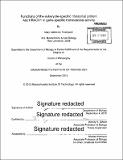Functions of the eukaryote-specific ribosomal protein Asc1 /RACK1 in gene-specific translational activity
Author(s)
Thompson, Mary Katherine
DownloadFull printable version (17.33Mb)
Other Contributors
Massachusetts Institute of Technology. Department of Biology.
Advisor
Wendy V. Gilbert.
Terms of use
Metadata
Show full item recordAbstract
Although the ribosome operates as a single molecular entity, it is composed of both ribosomal RNAs and dozens of proteins. However, the individual contributions of most ribosomal components to translational regulation are unknown. In Chapter 1, I will review the current state of knowledge related to the functions of ribosomal proteins with a focus on the RACK1 protein (Asc1 in yeast), a eukaryote-specific ribosomal protein with many proposed functions in both cellular signaling and translation. In Chapter 2, I will present evidence that the Asc1 protein is required for efficient translation of a specific set of mRNAs with short open reading frames (ORFs), including those that encode ribosomal proteins and nuclear-encoded mitochondrial components. Consistent with these translation defects, ASC1 mutants are unable to grow in conditions requiring full mitochondrial function. Asc1-sensitive mRNAs are highly associated with the translational closed-loop complex, a group of proteins that promotes a loop-like conformation of the mRNA during translation by simultaneous interaction with the 5' and 3' ends of the mRNA molecule. In wild type cells, mRNAs that associate strongly with the translational closed-loop complex are much shorter than other ORFs. Thus, I hypothesize that the closed-loop is preferentially formed and/or stabilized on mRNAs with short ORFs, and that this process is enhanced by the presence of Asc1 on the small ribosomal subunit. The dependence of closed-loop formation on ORF length could also explain why short ORFs have notably higher translation efficiency than longer ORFs, a trend I observed in data collected from several eukaryotes. In Chapter 3, I will present evidence that the mammalian RACK1 protein is also required for expression of mRNAs with short ORFs and for mitochondrial function in HeLa cells, similar to my observations in yeast. These findings hint at a conserved role for the Asc1/RACK1 protein in promoting the function of the closed-loop complex and the translation of short ORFs, which encode a set of highly abundant proteins required for central metabolic functions. Chapter 4 will discuss the biochemical and cell physiological implications of these findings and suggest some avenues for future research.
Description
Thesis: Ph. D., Massachusetts Institute of Technology, Department of Biology, 2015. Cataloged from PDF version of thesis. Includes bibliographical references.
Date issued
2015Department
Massachusetts Institute of Technology. Department of BiologyPublisher
Massachusetts Institute of Technology
Keywords
Biology.